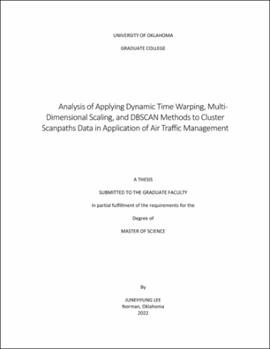| dc.contributor.advisor | Kang, Ziho | |
| dc.contributor.author | Lee, JuneHyung | |
| dc.date.accessioned | 2022-05-13T13:32:13Z | |
| dc.date.available | 2022-05-13T13:32:13Z | |
| dc.date.issued | 2022-05 | |
| dc.identifier.uri | https://hdl.handle.net/11244/335706 | |
| dc.description.abstract | Federal Aviation Administration (FAA) is interested in efficient ways to train air traffic controllers (ATCs) due to the high cost and long training time. It is known that exposing trainees to the visual scanpaths of experts in en route air traffic control environment can be an efficient way to improve trainees’ performance in a relatively short amount of time (Kang and Landry, 2014). It is unknown whether the experts’ visual scanning behaviors can be leveraged to better train the novices in the tower environment. To do so, first there should be a way to effectively analyze experts’ visual scanpaths. Therefore, in this research, it was investigated whether the approach introduced by Kang et al. (2018) was applicable in application of air traffic management in tower environment. | en_US |
| dc.language | en_US | en_US |
| dc.subject | Human Factors | en_US |
| dc.subject | Eye movement | en_US |
| dc.subject | FAA | en_US |
| dc.subject | DTW | en_US |
| dc.subject | DBSCAN | en_US |
| dc.subject | MDS | en_US |
| dc.title | Analysis of Applying Dynamic Time Warping, Multi- Dimensional Scaling, and DBSCAN Methods to Cluster Scanpaths Data in Application of Air Traffic Management | en_US |
| dc.contributor.committeeMember | Razzaghi, Talayeh | |
| dc.contributor.committeeMember | Zhu, Rui | |
| dc.date.manuscript | 2022-04 | |
| dc.thesis.degree | Master of Science | en_US |
| ou.group | Gallogly College of Engineering::School of Industrial and Systems Engineering | en_US |
